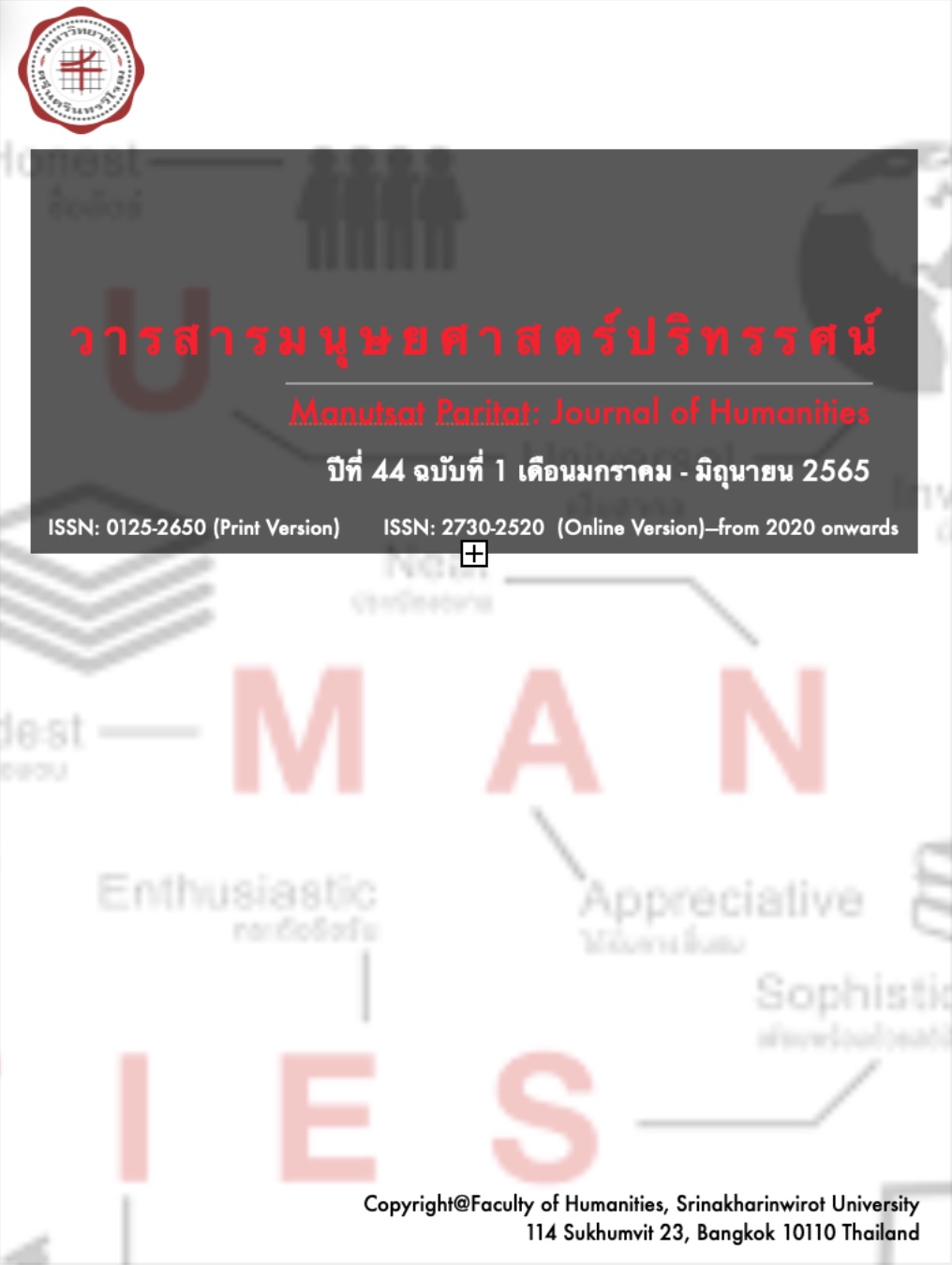A Comparison of Image Appearances in the Word “Chinese Dragon” in Thai Social Media
Main Article Content
Abstract
The purpose of this research is to compare how the image of a “Chinese dragon” appears in Thai social media. The research was carried out by collecting, evaluating, and comparing data from 35 websites through Google search engine using the term “Chinese dragon” in Thai. The results revealed that the websites illustrate a Chinese dragon as follows. A Chinese dragon may or may not have its wings. It can fly, and has tail, horns, mustaches, 4 legs, and 3-5 claws depending on the level of the feudal class. Parts of its body are derived from various different animals: Camel’s heads, antlers, rabbit’s eyes, bull’s ears, eagle’s wings, snake’s throat, tiger’s foot, eagle’s claws, frog’s or clam’s belly, and carp’s scales. Green, gold, blue, black, white, red, and yellow are the 7 colors presented on the scales. Green is being used most frequent. There are 117 scales containing 81 Yang/good scales and 36 Yin/bad scales. A crystal ball is on its forelegs. A Chinese dragon is a huge animal that can change its size as needed. 9 types of the Chinese dragon include horned dragon, winged dragon, celestial dragon, spiritual dragon, dragon of hidden treasures, coiling dragon, yellow dragon, underground dragon, dragon kings. Each type of the dragon serves different functions. Chinese dragon is friendly, compassionate, optimistic, ambitious behavior and kind. It has water-based power and abilities to spit fire, command wind, float in the air with its flexible body, subdue bad spirits, and fight against bad karma. Lastly, Chinese dragon symbolizes auspiciousness, greatness, divine beasts of heaven and earth, power, regal authority.
Article Details

This work is licensed under a Creative Commons Attribution-NonCommercial-NoDerivatives 4.0 International License.
Any unauthorized copying, publication, reproduction or distribution of copyrighted works appeared in Manutsat Paritat: Journal of Humanities is an infringement of the copyright owners’ rights. To authorize the copying, publication, reproduction or distribution of copyrighted works to be appeared in other printed materials or any online media, please write to MPJHthaijo@gmail.com for permission.
References
กนกวรรณ เขียววัน และคณะ. (2562). การศึกษาความสอดคล้องของเว็บไซต์มหาวิทยาลัยราชภัฏ กำแพงเพชรกับหลักการ Search Engine Optimization (SEO). รายงานสืบเนื่องจากการประชุมวิชาการระดับชาติ ครั้งที่ 5 สถาบันวิจัยและพัฒนา มหาวิทยาลัยราชภัฏกำแพงเพชร. (397). ม.ป.ท.
กัญญรัตน์ เวชชศาสตร์. (2559). มโนทัศน์เรื่องนาคของชนชาติไท. วารสาร Veridian E Journal ฯ สาขามนุษยศาสตร์ สังคมศาสตร์ มหาวิทยาลัยศิลปากร, 9(1), 1106.
ปรีชา พิณทอง. (2532). สารานุกรมภาษาอีสาน ไทย อังกฤษ. อุบลราชธานี: ศิริธรรม.
ราชบัณฑิตยสถานออนไลน์. (2554). มังกร. เข้าถึงได้จาก https://dictionary.orst.go.th/lookup_domain.php
สหรัฐ ศักดิ์ศิลปชัย. (ม.ป.ป.). การประชาสัมพันธ์ของกองสารนิเทศในการสร้างภาพลักษณ์ที่ดีให้กับสำนักงาน ตำรวจแห่งชาติ. (วิทยานิพนธ์หลักสูตรการป้องกันราชอาณาจักร, วิทยาลัยป้องกันราชอาณาจักร).
ส. พลายน้อย. (2556). เล่าเรื่องมังกร ตำนานหลากชนชาติ. (พิมพ์ครั้งที่ 6). กรุงเทพฯ: พิมพ์คำ.
Cambridge dictionary. (n.d.). Dragon. Retrieved December, 20, 2021 from shorturl.at/gyLN3.
Blacker, J. F. (1911). Chats on Oriental China. London: T. Fisher Unwin Adelphi Terrace.
Hodous, L. (1970). Folkways in China. London: Late Probsthain & Co.


